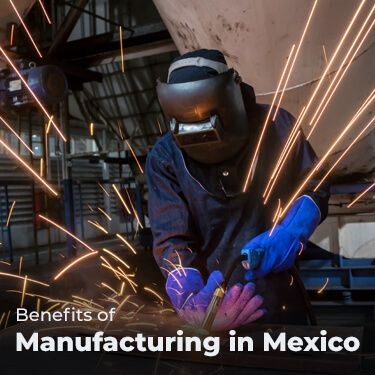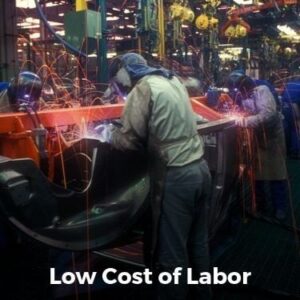
Por
 Copiar URL al Portapapeles
Copiar URL al Portapapeles
Manufacturing in Mexico has grown in popularity thanks to global factors and a number of important benefits for businesses. Ongoing trade wars and global conflict have caused many businesses to move or consider moving manufacturing elsewhere. Mexico has emerged as a popular destination for a variety of reasons. Businesses should be aware of these benefits to determine if manufacturing in Mexico is right for them.
The benefits of manufacturing in Mexico include:
These are just a few of the notable benefits that Mexico has to offer. The comprehensive guide below takes a close look at each of the benefits and why they may be worthwhile for your business.
Table of Contents

Instead of setting up your production halfway around the world, Mexico offers a place for your manufacturing operation near both the U.S. and Canadian markets.
With the North American Free Trade Agreement (NAFTA) in place, both the distance and relative ease of transportation are attractive selling points to any business considering operating in Mexico. Northern Mexico along the border from California to Texas is an industrialized place and several Mexican border cities offer quick access into the U.S.:
With the United States’ shared border with Mexico and its large network of developed infrastructure, quick turnaround times for shipping goods is not a dream — it’s a reality. Shipping goods starts at the 3,000 factories known as maquiladoras lining the 2,000-mile border between the U.S. and Mexico.
Orders can cross the border in mere hours and specialized orders may only take a couple of days. Compared to Asian countries, which can take weeks or months for production and transit, this is a huge time saver. On a truck, many U.S. destinations can be reached within a day’s time. Any location on the continental United States will have the load delivered
The savings extend to pure profits as well. With the product already on the North American continent, the cost savings will be great to businesses. The turnaround to realize profit will also be shorter because product could be manufactured and sold quicker.
There is also a reduced risk of trade being disrupted or slowed between the three countries because of NAFTA.

Labor costs in Mexico will be enticing as factory workers are paid a lot less than their American counterparts. Workers in the Mexican manufacturing industries are paid an average of over $2 per hour. According to Indeed.com, an American factory worker makes an average of just under $12 per hour.
In some cases, the discrepancy can be much wider. A job that once paid $30 an hour — assembling cables and electronics for installation in vehicles in the U.S. — is now done for $1 an hour in Mexico.
The wages in manufacturing are considered good-paying jobs in the Mexican labor force when considering the following:
The Mexican workweek is 48 hours long compared to 40 in the U.S., allowing for a potential 16% increase in output for your business. Suffice to say, setting up your manufacturing operations in Mexico will lead to big savings on employment alone.
The previous figures are just the wage though. Most companies consider the cost of labor to include both the salaries and benefits offered to employees. Even when accounting for benefits as well, Mexico consistently offers low costs for compensation:

With such a low cost in labor, it’s fair to wonder if the work being done is high quality. Coupled with the monetary savings is a highly-skilled workforce that can get the job done. Since some of the wages at maquiladoras are higher than wages paid in other Mexican industries, employee retention is better because turnover is generally low.
In turn, this leads to workers who’ve been trained and have the knowledge to properly work in a variety of manufacturing roles. In many cases, even when workers don’t have a wealth of experience, they have transferable skills that allow them to be trained to do more complex tasks.
Maquiladoras and the workers there have experience in manufacturing medical devices, electronics, automobiles and auto parts, textiles, plastics, appliances and furniture. Mexican workers also serve the aerospace and aviation industries. About 200 aerospace companies manufacture in Mexico and employ over 200,000 people.
Also Mexico has a median younger age than America (26 years compared to 37), about 47 million technically proficient people in the work force and boasts a literacy rate of 93 percent. The country has some catching up to do in several regards but is making vast improvements in the health, education and job market of its citizens.
In 2015, Mexico was graduating 111,000 engineering and tech students each year from its universities. That puts the country 8th in the world in that category.

Since the Border Industrialization Program (BIP) began in Mexico in 1965, the country began courting foreign investment. It was the beginning of the country lowering duties and restrictions on machinery, raw materials and equipment.
Besides the U.S., countries from Europe and Asia have also caught on to the advantages of manufacturing in Mexico. The automobile industry is a diverse example as the following brands now carry out a portion of their automotive manufacturing south of the border:
The auto industry, in particular, must be pleased with its return on investment in Mexico — Audi built a brand-new $1.3 billion factory in the state of Puebla in 2016. Automobiles are the top manufacturing industry in Mexico. Electronics are not behind far behind though, and have a much longer history in the North American country. Beginning not long after the start of the Maquiladora program’s start in the 1960s, facilities to make electronics started popping up all along the border between the U.S. and Mexico.
Really, the variety of companies extend to every corner of the business world. Coca-Cola has a huge presence in Mexico. Sabritas, a subsidiary of PepsiCo, sells popular Frito Lays snacks like Cheetos and Doritos and has an 80 percent share of the Mexican salty snack market. Food giant Nestle, which produces a plethora of edible items, has 18 production facilities throughout Mexico.
For a great case of how foreign companies view Mexico, one needs to look no further than the transformation of Guadalajara. The second-largest city in the country is in the state of Jalisco (which is known as the birthplace of Tequila) and is now referred to as the “Silicon Valley” of Mexico for its role as a huge hub for research and development. Companies such as HP, Amazon, Oracle, Intel and IBM all have R&D operations there.
But Guadalajara also has a booming manufacturing scene in place as well, with more than 1/3 of their gross domestic product coming from industry alone. Guadalajara is just one case of the level of investment foreign companies have made and continue to make in Mexico, which has the 15th largest economy in the world as of the end of 2018.
Some more reasons to invest in manufacturing in Mexico include:

Laws first enacted in the 1960s signaled the Mexican government’s intent to grow jobs, making Mexico a more alluring place for foreign companies to locate their businesses. The introduction of NAFTA in 1994 furthered that aim.
NAFTA is Mexico’s most notable trade partnership, which allows Mexico, Canada and the United States to sell goods freely to one another. The agreement also features reduced or completely waived tariffs and duties.
The partnership makes shipping to or from Mexico inherently less of a risk. There are also very few restrictions on what can be built in Mexico. Firearms production and even radioactive or nuclear items can be built within the country with proper permitting.
The IMMEX (or Maquiladora) program in Mexico is a popular setup used by foreign businesses to access the available workforce and also reap the benefits of tax breaks afforded by the arrangement. The company often owns the real estate and facilities, or can contract services from a Mexican company.
A maquiladora is a factory in Mexico owned by a foreign company as a subsidiary that sends materials or components to Mexico. The company then exports the finished product back to the country of origin. The enterprise is duty- and tariff-free. The overall incentives for companies are often superior than what they receive in their own country.
Maquiladoras are mostly set up along the border between the U.S. and Mexico, allowing raw materials to be exported to the maquiladoras, assembled and sent back to the U.S. Access to a young, willing workforce is another plus.
Fair Treatment of Intellectual Property
The United States is considered the strongest country when it comes to its treatment of Intellectual Property (IP), followed closely by the United Kingdom.
The reason this is relevant is because when doing business in Mexico, foreign companies based in Western Europe, Japan, South Korea and Australia won’t be able to expect the same protections they received in their own countries.
But that doesn’t mean it’s a bad idea to take your best ideas and implement them in Mexico. While there is still much work to be done, Mexico has made strides in honoring the IP of its countrymen and that of others.
The Global Innovation Policy Center — an affiliate of the U.S. Chamber of Commerce — released an International IP Index in 2018 to rate how effectively 50 countries worldwide measure up in regard to intellectual property.
Mexico was in the top half of the countries listed, coming in 24th. Areas where Mexico excelled on the metric included:
Still, Mexico is outside of other countries’ jurisdiction, so you should still register, protect and enforce your own rights on your IP. For example, the U.S. government can assist rights holders enforce IP claims but not if they’ve done nothing to try to secure their own IP.

While Mexicans are not afforded the same rights Americans enjoy in the workforce, there are laws and practices in place. Forced or child labor are both outlawed in Mexico, and discrimination of any kind in the workplace is illegal. This includes prejudices based on sex, pregnancy, gender identity and sexual orientation.
Also in May 2019, Mexican President Andres Manuel Lopez Obrador saw legislation revisions to Mexico’s Federal Labor Law pass. Although not enacted yet, the changes could result in a seismic shift for workers rights in the country. One area where this should have a big change is in how unions operate.
Before, unions were formed by the company and negotiations were done before a facility opened. Because of this, very few workers actually voted on union bylaws that would directly affect them. Now workers can organize and enter directly into collective bargaining negotiations with their employers.
This one change can’t be understated. Workers are no longer forced to join a company-friendly union and can create independent organizations without the threat of facing a hostile work environment. Companies will have to meet its employees on more equitable terms soon in Mexico, which could be mutually advantageous. Certain studies show that a happy worker is a more productive one as well.

One of the main draws of setting up your business in Mexico are the affordable operating costs. From previously mentioned labor cost advantages to cheap land and facilities, doing due diligence can help businesses save money in the short and long term.
Depending on location, the cost of land can range between $2.50 and $6 per square foot, with construction set at about $27 to $35 per square foot. An existing facility can be a very good value, if it fits your business needs — it’s about $4.20 to $5.60 per sq. ft.
Utilities can also be a sizable expense and consideration for large businesses. Companies need to ensure the infrastructure is in place for its water, electricity and gas access. If it is not, the next thought must focus on what the cost of implementing that access would be and if it is worth it in relation to setting up manufacturing there.
Keeping the lights on in Mexico for a large business has gone down in recent years and will generally cost between 9 to 11 cents per kilowatt hour. While that is higher than it is in the United States, the Mexican government has made changes to continue its push to be more competitive in that regard.
Supplying the business with water is charged at a rate of $5 to $9 per 1,000 gallons. For natural gas, it is between $5 and $7 for 1,000 British Thermal Units (BTUs).
Having to navigate the time difference between Asia or Europe and the United States when doing business can be a headache. No such trouble comes when trying to conduct business in Mexico. The vast majority of Mexico lies in the Central Time Zone, with parts also lying in Mountain and Pacific time.
Just one Mexican state on the end of the Yucatan Peninsula — Quintana Roo — observes the Southeastern Time, which doesn’t observe Daylight Savings time. So for half the year, Quintana Roo is on Eastern Standard Time and the other half is Central Time.
Checking in on your operations will also be easier. If there is an immediate problem that can only be addressed in person, towns along the Mexican border can all be reached in less than a day from anywhere in the continental United States. In many cases, it’s a matter of just a few hours depending on where your U.S.-based offices are located.
Also with the ubiquity of the internet, cell phones and the ability to video conference, it’s becoming less imperative to be there in person and much simpler to hash out minor issues from the comfort of your office. Whatever might arise, your Mexican-based manufacturing operations can be accessed in many different ways.

Setting up how you choose to conduct your business can depend on what your investment ends up being. There are several different ways you could set up your operation and each have their own distinct advantages and disadvantages:
However, this is the preferred operation for a foreign company that wants absolute control over all aspects of the business.
The biggest hurdle in this scenario is finding another company that shares your exact goals. While similar goals could make for a fruitful union, it could also cause problems if both are not aligned in key areas.
This setup allowed companies to quickly set up operations without maintaining a legal presence in Mexico. The reason it is referred to as a shelter operation is because it “shelters” foreign companies from many of the risks and liabilities associated with choosing to fully own manufacturing plants.
A typical shelter operation would be where the foreign company sent equipment, materials and supervisors to a maquiladora, which would provide the workers and human resources services. The maquiladora would also be responsible for importing and exporting, leasing the property, paying taxes, dealing with customs and abiding by any laws.
This can also be what a company is looking for when it is not looking to make a huge monetary investment to build its own facilities. Also quality, production and delivery are handled by the contractor which takes that pressure off the foreign business.
Furthermore, the way this differs from other setups is the independent manufacturer bills the foreign company on a per piece basis, which means the maquiladora is responsible for every aspect of the final product. The foreign company in question doesn’t have to worry about delivery or production quality, as it is handled by the maquiladora.
China is a huge manufacturer and exporter of goods worldwide. Any conversation about production of items is going to include the Asian country of more than 1.4 billion because of their position as a major global player.
However, the decision to outsource production to China is no longer the no-brainer it once was. Here are some reasons that it could be better to consider Mexico as the superior option:
Simply put, Mexico is much closer to the U.S. and Canada than China. This easily allows for less potential problems in the supply chain, quicker shipping times and less difficult for U.S. and Canadian companies to send key personnel down to Mexico in case of an event that requires a quick, in-person response.
Using Shanghai, China as a general reference point, it would be over 5,600 miles to Vancouver, Canada and about 6,500 miles to Los Angeles. You’d need to have your product shipped via plane (which can be very costly) or take up to 30 days on a freight ship across the Pacific Ocean.
Tijuana, Mexico to Vancouver is a little over 1,400 miles. Nuevo Laredo, Mexico is roughly 1,800 miles from Toronto, Canada. Mexico’s closeness to the United States, of course, is an obvious advantage when taking all of that into account.
There are a lot of different variables that go into the cost of shipping your product. But it stands to reason that in most cases, it would be less expensive to move your freight from Tijuana to Los Angeles (137 miles) than it would be to send it from Shanghai to L.A.
Theoretically, Mexico also offers a direct gateway to both Central and South America because of the proximity and the land and sea connection North and South America shares
So the greatest gross manufacturing happens in China, although Mexico has started to close the gap. But did you know that the average Mexican worker is actually more efficient than their Chinese counterpart?
So here’s how that works: While the production rate of both are close, their wages are not. An average Mexican employee makes about 50 cents less per hour than a Chinese employee doing a similar job. Essentially a business would get a greater cost benefit from its workers by setting up shop in Mexico based on that.
Speaking about the wages, for a skilled laborer, China pays an average of $4.50 an hour while in Mexico it’s about $4 per hour. Also the wages in Mexico are less prone to fluctuation, making it easier to project operational costs.
Depending on how much of a particular type of energy your business plans on using, it could be a savings to manufacture in Mexico.
Natural gas is specifically very inexpensive in the country, just like it is in the United States. Natural gas in China, though, could be anywhere from 50 to 300 percent more expensive than in the U.S. or Mexico.
The Mexican government has worked to make electricity competitively priced in Mexico but power is still higher than China or the U.S.
With tariffs imposed on Chinese steel and aluminum, and escalations of further duties implemented, the business relationship between the U.S. and China is tenuous at best. While the U.S. and Mexico have also verbally sparred in the past, the two countries absolutely depend on one another for commerce and tend to work out whatever differences occur.
NAFTA has been fruitful for both countries and the upcoming United States Mexico Canada Agreement (USMCA) shouldn’t do much to jeopardize that. Also the country’s currencies can make the exchange rate more favorable for doing business in Mexico.
The Chinese Yuan is closely linked to the U.S. dollar, which means it fluctuates in concert with it. But because of concerns over China purposely devaluing the value of their own currency — known as a form of currency manipulation — the cost of doing business in China can sometimes prove to be complicated. Basically, China artificially keeps the value of the yuan low so its exports to the U.S. and other countries can remain cheap.
Meanwhile, the Mexican Peso is not prone to any alleged financial trickery nor tied directly to the U.S. dollar. The currency can be affected by global conditions of course, but is not at risk of being shaped by the government to gain itself better deals or look more attractive when importing or exporting products.
Now that you know the benefits of manufacturing in Mexico, let R+L Global Logistics handle transporting your valuable goods. R+L Global Logistics can ship both to and from maquiladores in Mexico, providing door-to-door service. We have a 99.5% on-time rating and can offer your business full supply chain management.
Get a quote today and see how R+L Global Logistics can help your business thrive.
 Copiar URL en el Portapapeles
Copiar URL en el Portapapeles
